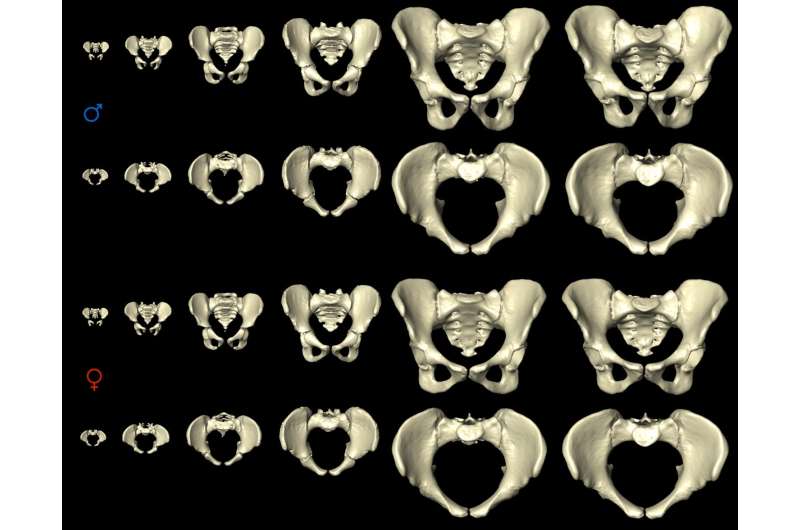The female pelvis adjusts for childbearing years

Mother Nature has the answer: With the onset of puberty, the female pelvis expands; with the onset of menopause, it contracts again. In contrast, the male pelvis remains on the same developmental trajectory throughout a lifetime. The striking results of a study by the University of Zurich suggest that the morphology of the female pelvis is influenced by hormonal changes in puberty and during menopause.
Women have wider hips than men because their pelves must allow for the birth of large-brained babies. Nevertheless, many female pelves are still not wide enough, which can result in difficult births. Traditionally, the human pelvis has been considered an evolutionary compromise between birthing and walking upright; a wider pelvis would compromise efficient bipedal locomotion. But this hypothesis has now been called into question: According to new studies, wide hips do not reduce locomotor efficiency.
A team of researchers led by Marcia Ponce de León at the Anthropological Institute of the University of Zurich has gained new insights. Using computed tomographic data, they tracked pelvic development from birth to old age and found that until puberty, male and female pelves are similar in width. With the onset of puberty, the male pelvis remains on the same developmental trajectory, while the female pelvis develops in an entirely new direction, becoming wider and reaching its full width around the age of 25-30 years. From the age of 40 onward, the female pelvis then begins to narrow again.
Difficult Childbirths Are Not an Evolutionary Problem
The researchers hypothesize that these processes are steered by changes in hormone levels. With the onset of puberty, estrogen concentration reaches high levels, which are maintained until menopause. High estrogen levels thus maintain high fertility and also guarantee that the female pelvis develops and maintains its obstetrically most favorable form. "This implies that the female body can modulate its pelvic dimensions 'on demand', and is not dependent on genetically fixed developmental programs," explains Ponce de León. At the same time, hormone levels also depend on environmental and nutritional factors. "This suggests that difficult childbirths are not necessarily an evolutionary mis-step, but more a question of the balance between the hormones and the external factors influencing the size of the birth canal and the prenatal development of the child."
But why does the female pelvis contract again with the onset of menopause? The researchers assume that a narrow pelvis is better suited to stabilizing the pelvic floor and thus to withstanding the high pressures that are generated in the abdomen during bipedal walking. As such, men and women become more similar from the age of 40 - at least as far as their pelves are concerned.
More information: Developmental evidence for obstetric adaptation of the human female pelvis, PNAS, www.pnas.org/cgi/doi/10.1073/pnas.1517085113

















